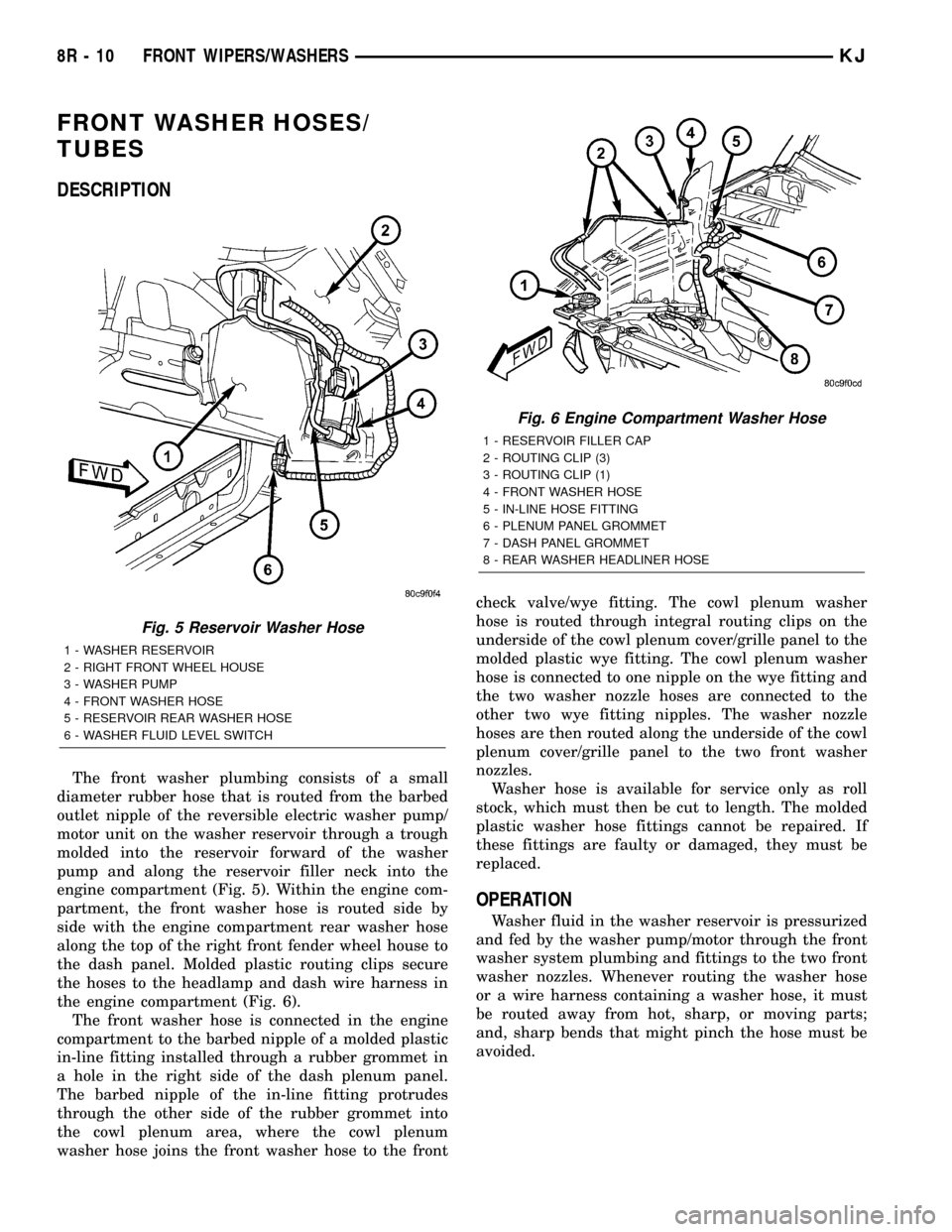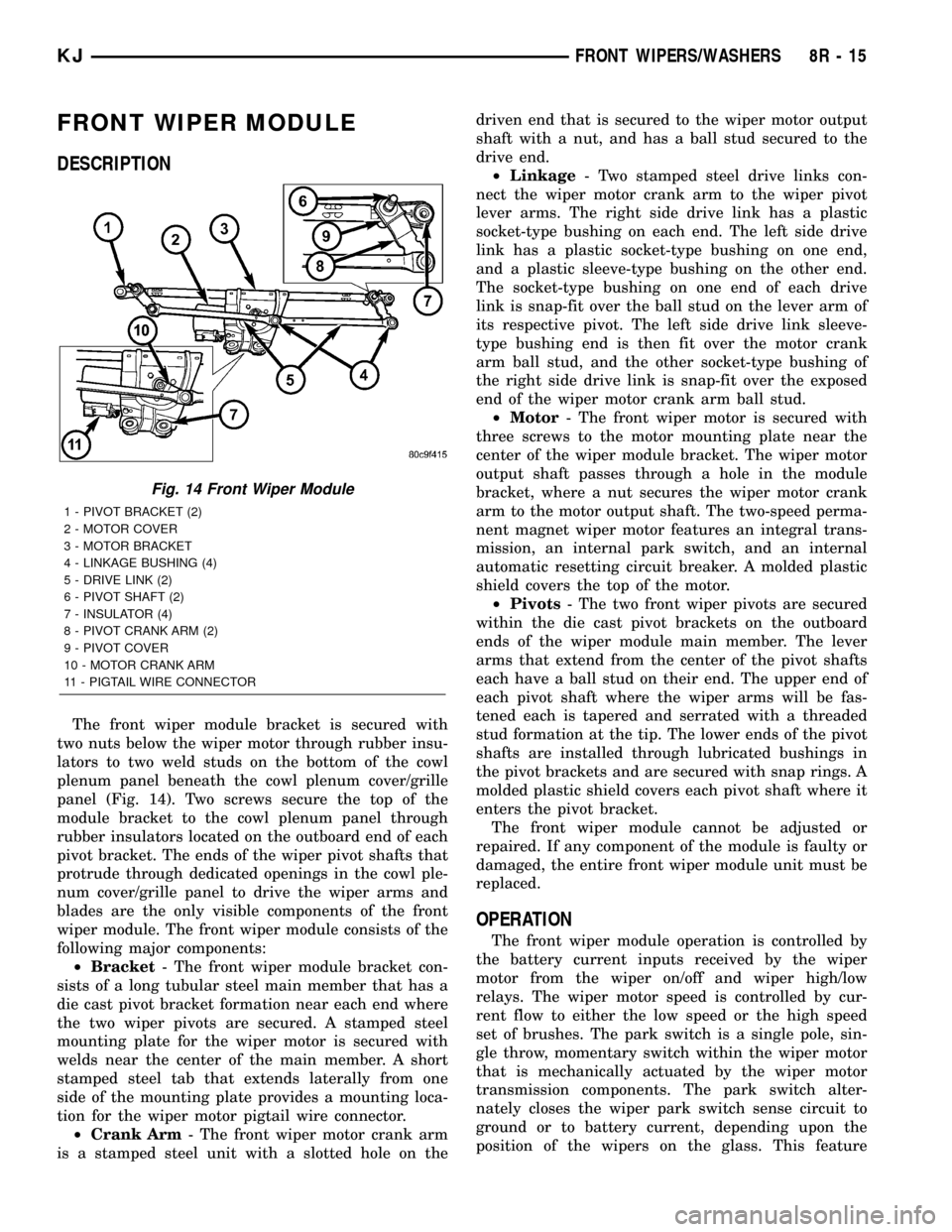pg 8 JEEP LIBERTY 2002 KJ / 1.G Workshop Manual
[x] Cancel search | Manufacturer: JEEP, Model Year: 2002, Model line: LIBERTY, Model: JEEP LIBERTY 2002 KJ / 1.GPages: 1803, PDF Size: 62.3 MB
Page 711 of 1803

FRONT WASHER HOSES/
TUBES
DESCRIPTION
The front washer plumbing consists of a small
diameter rubber hose that is routed from the barbed
outlet nipple of the reversible electric washer pump/
motor unit on the washer reservoir through a trough
molded into the reservoir forward of the washer
pump and along the reservoir filler neck into the
engine compartment (Fig. 5). Within the engine com-
partment, the front washer hose is routed side by
side with the engine compartment rear washer hose
along the top of the right front fender wheel house to
the dash panel. Molded plastic routing clips secure
the hoses to the headlamp and dash wire harness in
the engine compartment (Fig. 6).
The front washer hose is connected in the engine
compartment to the barbed nipple of a molded plastic
in-line fitting installed through a rubber grommet in
a hole in the right side of the dash plenum panel.
The barbed nipple of the in-line fitting protrudes
through the other side of the rubber grommet into
the cowl plenum area, where the cowl plenum
washer hose joins the front washer hose to the frontcheck valve/wye fitting. The cowl plenum washer
hose is routed through integral routing clips on the
underside of the cowl plenum cover/grille panel to the
molded plastic wye fitting. The cowl plenum washer
hose is connected to one nipple on the wye fitting and
the two washer nozzle hoses are connected to the
other two wye fitting nipples. The washer nozzle
hoses are then routed along the underside of the cowl
plenum cover/grille panel to the two front washer
nozzles.
Washer hose is available for service only as roll
stock, which must then be cut to length. The molded
plastic washer hose fittings cannot be repaired. If
these fittings are faulty or damaged, they must be
replaced.
OPERATION
Washer fluid in the washer reservoir is pressurized
and fed by the washer pump/motor through the front
washer system plumbing and fittings to the two front
washer nozzles. Whenever routing the washer hose
or a wire harness containing a washer hose, it must
be routed away from hot, sharp, or moving parts;
and, sharp bends that might pinch the hose must be
avoided.
Fig. 5 Reservoir Washer Hose
1 - WASHER RESERVOIR
2 - RIGHT FRONT WHEEL HOUSE
3 - WASHER PUMP
4 - FRONT WASHER HOSE
5 - RESERVOIR REAR WASHER HOSE
6 - WASHER FLUID LEVEL SWITCH
Fig. 6 Engine Compartment Washer Hose
1 - RESERVOIR FILLER CAP
2 - ROUTING CLIP (3)
3 - ROUTING CLIP (1)
4 - FRONT WASHER HOSE
5 - IN-LINE HOSE FITTING
6 - PLENUM PANEL GROMMET
7 - DASH PANEL GROMMET
8 - REAR WASHER HEADLINER HOSE
8R - 10 FRONT WIPERS/WASHERSKJ
Page 712 of 1803

FRONT WASHER NOZZLE
DESCRIPTION
The two front washer nozzles have integral snap
features and an anti-rotation tab that secure them in
dedicated holes in the cowl plenum cover/grille panel
located near the base of the windshield (Fig. 7). The
domed upper surface of the washer nozzle is visible
on the top of the plenum cover/grille panel, and the
nozzle orifice is oriented towards the windshield
glass. The washer plumbing fittings for the washer
nozzles are concealed beneath the cowl plenum cover/
grille panel. These fluidic washer nozzles are con-
structed of molded plastic. The cowl plenum cover/
grille panel must be removed from the vehicle to
access the nozzles for service. The washer nozzles
cannot be adjusted or repaired. If faulty or damaged,
they must be replaced.
OPERATION
The two front washer nozzles are designed to dis-
pense washer fluid into the wiper pattern area on the
outside of the windshield glass. Pressurized washer
fluid is fed to each nozzle from the washer reservoir
by the washer pump/motor unit through a single
hose, which is attached to a barbed nipple on each
front washer nozzle below the cowl plenum cover/
grille panel. The washer nozzles incorporate a fluidic
design, which causes the nozzle to emit the pressur-
ized washer fluid as an oscillating stream to more
effectively cover a larger area of the glass area to be
cleaned.
REMOVAL
(1) Unlatch and open the hood.
(2) Remove both front wiper arms from the wiper
pivots. (Refer to 8 - ELECTRICAL/WIPERS/WASH-
ERS/FRONT WIPER ARM - REMOVAL).
(3) Remove the cowl plenum cover/grille panel
from over the cowl plenum. (Refer to 23 - BODY/EX-
TERIOR/COWL GRILLE - REMOVAL).
(4) From the underside of the cowl plenum cover/
grille panel, disconnect the washer nozzle hose from
the barbed nipple of the front washer nozzle (Fig. 8).
(5)
From the underside of the cowl grille cover,
release the integral snap features of the front washer
nozzle and push the nozzle out through the mounting
hole toward the top side of the cowl plenum cover/grille
panel.
(6) Remove the front washer nozzle from the top of
the cowl plenum cover/grille panel.
INSTALLATION
(1) From the top of the cowl plenum cover/grille
panel, position the nipple end of the front washer
nozzle through the mounting hole and engage the
anti-rotation tab of the nipple into the anti-rotation
notch in the mounting hole.
(2) Push firmly and evenly on the top of the front
washer nozzle until the integral snap features lock
into place on the underside of the cowl plenum cover/
grille panel.
(3) From the underside of the cowl grille cover,
reconnect the washer hose to the barbed nipple of the
front washer nozzle (Fig. 8).
(4) Reinstall the washer hose for the front washer
nozzle into its routing clips on the underside of the
cowl plenum cover/grille panel.
Fig. 7 Front Washer Nozzle
1 - NIPPLE
2 - ANTI-ROTATION TAB
3 - FRONT WASHER NOZZLE
4 - ORIFICE
5 - LATCH (2)
Fig. 8 Front Washer Nozzle Remove/Install
1 - COWL GRILLE COVER (UNDERSIDE)
2 - FRONT WASHER NOZZLE
3 - WASHER NOZZLE HOSE
KJFRONT WIPERS/WASHERS 8R - 11
Page 713 of 1803

(5) Reinstall the cowl plenum cover/grille panel
over the cowl plenum. (Refer to 23 - BODY/EXTERI-
OR/COWL GRILLE - INSTALLATION).
(6) Reinstall both front wiper arms onto the wiper
pivots. (Refer to 8 - ELECTRICAL/FRONT WIPERS/
WASHERS/FRONT WIPER ARM - INSTALLATION).
(7) Close and latch the hood.
FRONT WIPER ARM
DESCRIPTION
The front wiper arms are the rigid members located
between the wiper pivots that protrude from the cowl
plenum cover/grille panel near the base of the wind-
shield and the wiper blades on the windshield glass
(Fig. 9). These wiper arms feature an over-center hinge
that allows easy access to the windshield glass for
cleaning. The wiper arm has a die cast metal pivot end
with a large tapered mounting hole at one end. A
molded black plastic cap fits over the wiper arm retain-
ing nut to conceal the nut and this mounting hole fol-
lowing wiper arm installation. The wide end of a
tapered, stamped steel channel hinges on and is secured
with a hinge pin to the blade end of the wiper arm pivot
end. One end of a long, rigid, stamped steel strap, with
a small hole near its pivot end, is riveted and crimped
within the narrow end of the stamped steel channel.
The tip of the wiper blade end of this strap is bent back
under itself to form a small hook. Concealed within the
stamped steel channel, one end of a long spring is
engaged with a wire hook on the underside of the diecast pivot end, while the other end of the spring is
hooked through the small hole in the steel strap. The
entire wiper arm has a satin black finish applied to all
of its visible surfaces.
A wiper arm cannot be adjusted or repaired. If
damaged or faulty, the entire wiper arm unit must be
replaced.
OPERATION
The front wiper arms are designed to mechanically
transmit the motion from the wiper pivots to the wiper
blades. The wiper arm must be properly indexed to the
wiper pivot in order to maintain the proper wiper blade
travel on the glass. The tapered mounting hole in the
wiper arm pivot end interlocks with the serrations on
the tapered outer circumference of the wiper pivot shaft,
allowing positive engagement and finite adjustment of
this connection. The mounting nut locks the wiper arm
to the threaded stud of the wiper pivot shaft. The
spring-loaded wiper arm hinge controls the down-force
applied through the tip of the wiper arm to the wiper
blade on the glass. The hook formation on the tip of the
wiper arm provides a cradle for securing and latching
the wiper blade pivot block to the wiper arm.
REMOVAL
(1) Lift the front wiper arm to its over-center posi-
tion to hold the wiper blade off of the glass and
relieve the spring tension on the wiper arm to wiper
pivot shaft connection.
(2) Carefully pry the plastic nut cap off of the
pivot end of the wiper arm (Fig. 10).
(3) Remove the nut that secures the wiper arm to
the wiper pivot shaft.
Fig. 9 Front Wiper Arm
1 - HOOK
2 - STRAP
3 - CHANNEL
4 - PIVOT END
5 - PIVOT HOLE
6 - HINGE PIN
7 - TENSION SPRING
Fig. 10 Front Wiper Arm Remove/Install
1 - FRONT WIPER BLADE & ARM (2)
2 - CAP (2)
3 - NUT (2)
4 - PIVOT SHAFT (2)
5 - T-SHAPED ALIGNMENT MARK (2)
8R - 12 FRONT WIPERS/WASHERSKJ
FRONT WASHER NOZZLE (Continued)
Page 714 of 1803

(4) If necessary, use a suitable battery terminal
puller to disengage the wiper arm from the wiper
pivot shaft (Fig. 11).
(5) Remove the front wiper arm pivot end from the
wiper pivot shaft.
INSTALLATION
NOTE: Be certain that the wiper motor is in the park
position before attempting to install the front wiper
arms. Turn the ignition switch to the On position
and move the control knob on the right (wiper) con-
trol stalk of the multi-function switch to its Off posi-
tion. If the wiper pivots move, wait until they stop
moving, then turn the ignition switch back to the
Off position. The wiper motor is now in its park
position.
(1) The front wiper arms must be indexed to the
wiper pivot shafts with the wiper motor in the park
position to be properly installed. Position the front
wiper arm pivot ends onto the wiper pivot shafts so
that the tip of the wiper blade is aligned with the
T-shaped wiper alignment lines located in the lower
edge of the windshield glass (Fig. 10).
(2) Once the wiper blade is aligned, lift the wiper
arm away from the windshield slightly to relieve the
spring tension on the pivot end and push the pivot
hole on the end of the wiper arm down firmly and
evenly over the wiper pivot shaft.
(3) Install and tighten the nut that secures the
wiper arm to the wiper pivot shaft. Tighten the nut
to 24 N´m (18 ft. lbs.).
(4) Wet the windshield glass, then operate the
front wipers. Turn the front wipers Off, then checkfor the correct wiper arm position and readjust as
required.
(5) Reinstall the plastic nut cap onto the wiper
arm pivot nut.
FRONT WIPER BLADE
DESCRIPTION
Each front wiper blade is secured by an integral
latching pivot block to the hook formation on the tip
of the front wiper arms, and rests on the glass near
the base of the windshield when the wipers are not
in operation (Fig. 12). The wiper blade consists of the
following components:
²Superstructure- The superstructure includes
several stamped steel bridges and links with claw
formations that grip the wiper blade element. Also
included in this unit is the latching, molded plastic
pivot block that secures the superstructure to the
wiper arm. The driver side front wiper blade has an
additional molded black plastic airfoil secured to the
superstructure, which is oriented toward the base of
the windshield when the front wipers are in their
parked position. All of the metal components of the
wiper blade have a satin black finish applied.
²Element- The wiper element or squeegee is the
resilient rubber member of the wiper blade that con-
tacts the glass.
²Flexor- The flexor is a rigid metal component
running along the length of each side of the wiper
Fig. 11 Wiper Arm Puller - Typical
1 - WIPER ARM
2 - WIPER PIVOT SHAFT
3 - BATTERY TERMINAL PULLER
Fig. 12 Front Wiper Blade
1 - SUPERSTRUCTURE
2 - ELEMENT
3 - PIVOT BLOCK
4 - RELEASE TAB
5 - PIVOT PIN
6 - CLAWS
7 - FLEXOR
KJFRONT WIPERS/WASHERS 8R - 13
FRONT WIPER ARM (Continued)
Page 715 of 1803

element where it is gripped by the claws of the
superstructure.
All models have two 47.50 centimeter (18.70 inch)
long front wiper blades with non-replaceable rubber
elements (squeegees). The wiper blades cannot be
adjusted or repaired. If faulty, worn, or damaged the
entire wiper blade unit must be replaced.
OPERATION
The wiper blades are moved back and forth across
the glass by the wiper arms when the wipers are
being operated. The wiper blade superstructure is
the flexible frame that grips the wiper blade element
and evenly distributes the force of the spring-loaded
wiper arm along the length of the element. The com-
bination of the wiper arm force and the flexibility of
the superstructure makes the element conform to
and maintain proper contact with the glass, even as
the blade is moved over the varied curvature that
may be encountered across the glass surface. The
wiper element flexor provides the claws of the blade
superstructure with a rigid, yet flexible component
on the element which can be gripped. The rubber ele-
ment is designed to be stiff enough to maintain an
even cleaning edge as it is drawn across the glass,
yet resilient enough to conform to the glass surface
and flip from one cleaning edge to the other each
time the wiper blade changes directions. The airfoil
used on the driver side wiper blade is designed to
reduce the lifting effect caused by air moving over
the vehicle at higher highway speeds.
REMOVAL
NOTE: The notched end of the wiper element flexor
should always be oriented towards the end of the
wiper blade that is nearest to the wiper pivot.
(1) Lift the front wiper arm to raise the wiper
blade and element off of the glass, until the wiper
arm hinge is in its over-center position.
(2) To remove the wiper blade from the wiper arm,
depress the pivot block latch release tab under the
tip of the arm and slide the blade away from the tip
towards the pivot end of the arm far enough to dis-
engage the pivot block from the hook formation on
the end of the arm (Fig. 13).
(3) Extract the hook formation on the tip of the
wiper arm through the opening in the wiper blade
superstructure just ahead of the wiper blade pivot
block/latch unit.
CAUTION: Do not allow the wiper arm to spring
back against the glass without the wiper blade in
place or the glass may be damaged.(4) Gently lower the tip of the wiper arm onto the
glass.
INSTALLATION
NOTE: The notched end of the wiper element flexor
should always be oriented towards the end of the
wiper blade that is nearest to the wiper pivot.
(1) Lift the front wiper arm off of the windshield
glass, until the wiper arm hinge is in its over-center
position.
(2) Position the front wiper blade near the hook
formation on the tip of the arm with the notched end
of the wiper element flexor oriented towards the end
of the wiper arm that is nearest to the wiper pivot.
(3) Insert the hook formation on the tip of the
wiper arm through the opening in the wiper blade
superstructure ahead of the wiper blade pivot block/
latch unit far enough to engage the pivot block into
the hook (Fig. 13).
(4) Slide the wiper blade pivot block/latch up into
the hook formation on the tip of the wiper arm until
the latch release tab snaps into its locked position.
Latch engagement will be accompanied by an audible
click.
(5) Gently lower the wiper blade onto the glass.
Fig. 13 Front Wiper Blade Remove/Install
1 - SUPERSTRUCTURE
2 - WIPER ARM
3 - PIVOT BLOCK
4 - RELEASE TAB
5 - HOOK
6 - ELEMENT
8R - 14 FRONT WIPERS/WASHERSKJ
FRONT WIPER BLADE (Continued)
Page 716 of 1803

FRONT WIPER MODULE
DESCRIPTION
The front wiper module bracket is secured with
two nuts below the wiper motor through rubber insu-
lators to two weld studs on the bottom of the cowl
plenum panel beneath the cowl plenum cover/grille
panel (Fig. 14). Two screws secure the top of the
module bracket to the cowl plenum panel through
rubber insulators located on the outboard end of each
pivot bracket. The ends of the wiper pivot shafts that
protrude through dedicated openings in the cowl ple-
num cover/grille panel to drive the wiper arms and
blades are the only visible components of the front
wiper module. The front wiper module consists of the
following major components:
²Bracket- The front wiper module bracket con-
sists of a long tubular steel main member that has a
die cast pivot bracket formation near each end where
the two wiper pivots are secured. A stamped steel
mounting plate for the wiper motor is secured with
welds near the center of the main member. A short
stamped steel tab that extends laterally from one
side of the mounting plate provides a mounting loca-
tion for the wiper motor pigtail wire connector.
²Crank Arm- The front wiper motor crank arm
is a stamped steel unit with a slotted hole on thedriven end that is secured to the wiper motor output
shaft with a nut, and has a ball stud secured to the
drive end.
²Linkage- Two stamped steel drive links con-
nect the wiper motor crank arm to the wiper pivot
lever arms. The right side drive link has a plastic
socket-type bushing on each end. The left side drive
link has a plastic socket-type bushing on one end,
and a plastic sleeve-type bushing on the other end.
The socket-type bushing on one end of each drive
link is snap-fit over the ball stud on the lever arm of
its respective pivot. The left side drive link sleeve-
type bushing end is then fit over the motor crank
arm ball stud, and the other socket-type bushing of
the right side drive link is snap-fit over the exposed
end of the wiper motor crank arm ball stud.
²Motor- The front wiper motor is secured with
three screws to the motor mounting plate near the
center of the wiper module bracket. The wiper motor
output shaft passes through a hole in the module
bracket, where a nut secures the wiper motor crank
arm to the motor output shaft. The two-speed perma-
nent magnet wiper motor features an integral trans-
mission, an internal park switch, and an internal
automatic resetting circuit breaker. A molded plastic
shield covers the top of the motor.
²Pivots- The two front wiper pivots are secured
within the die cast pivot brackets on the outboard
ends of the wiper module main member. The lever
arms that extend from the center of the pivot shafts
each have a ball stud on their end. The upper end of
each pivot shaft where the wiper arms will be fas-
tened each is tapered and serrated with a threaded
stud formation at the tip. The lower ends of the pivot
shafts are installed through lubricated bushings in
the pivot brackets and are secured with snap rings. A
molded plastic shield covers each pivot shaft where it
enters the pivot bracket.
The front wiper module cannot be adjusted or
repaired. If any component of the module is faulty or
damaged, the entire front wiper module unit must be
replaced.
OPERATION
The front wiper module operation is controlled by
the battery current inputs received by the wiper
motor from the wiper on/off and wiper high/low
relays. The wiper motor speed is controlled by cur-
rent flow to either the low speed or the high speed
set of brushes. The park switch is a single pole, sin-
gle throw, momentary switch within the wiper motor
that is mechanically actuated by the wiper motor
transmission components. The park switch alter-
nately closes the wiper park switch sense circuit to
ground or to battery current, depending upon the
position of the wipers on the glass. This feature
Fig. 14 Front Wiper Module
1 - PIVOT BRACKET (2)
2 - MOTOR COVER
3 - MOTOR BRACKET
4 - LINKAGE BUSHING (4)
5 - DRIVE LINK (2)
6 - PIVOT SHAFT (2)
7 - INSULATOR (4)
8 - PIVOT CRANK ARM (2)
9 - PIVOT COVER
10 - MOTOR CRANK ARM
11 - PIGTAIL WIRE CONNECTOR
KJFRONT WIPERS/WASHERS 8R - 15
Page 717 of 1803

allows the motor to complete its current wipe cycle
after the wiper system has been turned Off, and to
park the wiper blades in the lowest portion of the
wipe pattern. The automatic resetting circuit breaker
protects the motor from overloads. The wiper motor
crank arm, the two wiper linkage members, and the
two wiper pivots mechanically convert the rotary out-
put of the wiper motor to the back and forth wiping
motion of the wiper arms and blades on the glass.
REMOVAL
(1) Unlatch and open the hood.
(2) Disconnect and isolate the battery negative
cable.
(3) Remove both front wiper arms from the wiper
pivots. (Refer to 8 - ELECTRICAL/WIPERS/WASH-
ERS - FRONT/FRONT WIPER ARM - REMOVAL).
(4) Remove the cowl plenum cover/grille panel
from over the cowl plenum. (Refer to 23 - BODY/EX-
TERIOR/COWL GRILLE - REMOVAL).
(5) Disconnect the headlamp and dash wire har-
ness connector for the front wiper motor from the
motor pigtail wire connector (Fig. 15).
(6) Remove the two screws that secure the front
wiper module to the top of the cowl plenum panel at
the pivot brackets.
(7) Remove the two nuts that secure the front
wiper module to the two weld studs on the bottom of
the cowl plenum panel.
(8) Lift the front wiper module up from the cowl
plenum panel far enough to disengage the two lower
insulators from the weld studs on the bottom of the
plenum panel.(9) Remove the front wiper module from the cowl
plenum panel as a unit.
INSTALLATION
(1) Position the front wiper module to the cowl ple-
num as a unit (Fig. 15).
(2) Lower the front wiper module lower mounting
insulators over the two weld studs on the bottom of
the cowl plenum panel.
(3) Install the two screws that secure the front
wiper module to the top of the cowl plenum panel at
the pivot brackets. Tighten the screw on the driver
side, followed by the screw on the passenger side.
Tighten the screws to 8 N´m (72 in. lbs.).
(4) Install and tighten the two nuts that secure
the front wiper module to the two weld studs on the
bottom of the cowl plenum panel. Tighten the nuts to
8 N´m (72 in. lbs.).
(5) Reconnect the headlamp and dash wire harness
connector for the front wiper motor to the motor pig-
tail wire connector.
(6) Reinstall the cowl plenum cover/grille panel
over the cowl plenum. (Refer to 23 - BODY/EXTERI-
OR/COWL GRILLE - INSTALLATION).
(7) Close and latch the hood.
(8) Reinstall both front wiper arms onto the wiper
pivots. (Refer to 8 - ELECTRICAL/FRONT WIPERS/
WASHERS/FRONT WIPER ARM - INSTALLATION).
(9) Reconnect the battery negative cable.
FRONT WIPER/WASHER
SWITCH
DESCRIPTION
The front wiper and washer switches are integral
to the right (wiper) control stalk of the multi-function
switch. (Refer to 8 - ELECTRICAL/LAMPS/LIGHT-
ING - EXTERIOR/MULTI-FUNCTION SWITCH -
DESCRIPTION).
OPERATION
The front wiper and washer switches are integral
to the right (wiper) control stalk of the multi-function
switch. (Refer to 8 - ELECTRICAL/LAMPS/LIGHT-
ING - EXTERIOR/MULTI-FUNCTION SWITCH -
OPERATION).
Fig. 15 Front Wiper Module Remove/Install
1 - NUT (2)
2 - SCREW (2)
3 - FRONT WIPER MODULE
4 - STUD (2)
5 - WIRE HARNESS CONNECTOR
8R - 16 FRONT WIPERS/WASHERSKJ
FRONT WIPER MODULE (Continued)
Page 718 of 1803

WASHER FLUID LEVEL
SWITCH
DESCRIPTION
The washer fluid level switch is a single pole, sin-
gle throw reed-type switch mounted at the rear of
the sump area near the bottom of the washer reser-
voir (Fig. 16). Only the molded plastic switch mount-
ing flange and the integral connector receptacle are
visible when the switch is installed in the reservoir.
A short nipple formation extends from the inner sur-
face of the switch mounting flange, and a barb on the
nipple near the switch mounting flange is pressed
through a rubber grommet seal installed in the
mounting hole of the reservoir. A small, molded plas-
tic float has two pivot pins near its center that are
snapped into two receptacles near the ends of two
stanchions that extend toward the float from the
switch nipple formation. A small magnet is secured
within the end of the float nearest the switch nipple
formation, and a reed switch is concealed within the
nipple. A diagnostic resistor is connected between the
two switch terminals within the switch mounting
flange. The washer fluid level switch cannot be
adjusted or repaired. If faulty or damaged, the switch
must be replaced.
OPERATION
The washer fluid level switch uses a pivoting,
oblong float to monitor the level of the washer fluid
in the washer reservoir. The float contains a small
magnet. When the float pivots, the proximity of this
magnet to a stationary reed switch within the nipple
formation of the switch changes. When the fluid level
in the washer reservoir is at or above the float level,
the float moves to a vertical position, the influence of
the float magnetic field is removed from the reed
switch, and the normally open reed switch contacts
open. When the fluid level in the washer reservoir
falls below the level of the pivoting float, the float
moves to a horizontal position, the influence of the
float magnetic field is applied to the reed switch, and
the contacts of the normally open reed switch close.
The washer fluid level switch is connected to the
vehicle electrical system through a dedicated take
out and connector of the headlamp and dash wire
harness. The switch is connected in series between
ground and the washer fluid switch sense input to
the ElectroMechanical Instrument Cluster (EMIC).
The switch receives a path to ground at all times
through another take out of the headlamp and dash
wire harness with a single eyelet terminal connector
that is secured under a ground screw near the front
of the left front fender inner shield in the engine
compartment. When the switch closes, the EMIC
senses the ground on the washer fluid switch sense
circuit. The EMIC is programmed to respond to this
input by illuminating the washer fluid indicator and
by sounding an audible chime tone warning.
The washer fluid level switch input to the EMIC
can be diagnosed using conventional diagnostic tools
and methods. (Refer to 8 - ELECTRICAL/INSTRU-
MENT CLUSTER/WASHER FLUID INDICATOR -
DIAGNOSIS AND TESTING).
REMOVAL
The washer fluid level switch can be removed from
the washer reservoir without removing the reservoir
from the vehicle.
(1) Disconnect and isolate the battery negative
cable.
(2) Raise and support the vehicle.
(3) Remove the splash shield from the right front
fender wheel house. (Refer to 23 - BODY/EXTERIOR/
FRONT WHEELHOUSE SPLASH SHIELD -
REMOVAL).
(4) Disconnect the front or rear washer hose from
one of the barbed outlet nipples of the washer pump/
motor unit and allow the washer fluid to drain into a
clean container for reuse.
(5) Disconnect the headlamp and dash wire har-
ness connector for the washer fluid level switch from
the switch connector receptacle (Fig. 17).
Fig. 16 Washer Fluid Level Switch
1 - MOUNTING FLANGE
2 - BARBED NIPPLE
3 - FLOAT
4 - RESERVOIR
5 - GROMMET SEAL
6 - PIVOT
7 - MAGNET
8 - CONNECTOR RECEPTACLE
KJFRONT WIPERS/WASHERS 8R - 17
Page 719 of 1803

NOTE: The pivoting float of the washer fluid level
switch must be in a horizontal position within the
reservoir in order to be removed. With the reservoir
empty and in an upright position, the pivoting float
will orient itself to the horizontal position when the
switch connector receptacle is pointed straight
downwards.
(6) Using a trim stick or another suitable wide
flat-bladed tool, gently pry the barbed nipple of the
washer fluid level switch out of the rubber grommet
seal on the back of the reservoir sump. Care must be
taken not to damage the reservoir.
(7) Remove the washer fluid level switch from the
washer reservoir.
(8) Remove the rubber grommet seal from the
washer fluid level switch mounting hole in the
washer reservoir and discard.
INSTALLATION
(1) Install a new rubber grommet seal into the
washer fluid level switch mounting hole in the
washer reservoir. Always use a new rubber grommet
seal on the reservoir.
(2) Insert the float of the washer fluid level switch
through the rubber grommet seal and into thewasher reservoir. The connector receptacle of the
washer fluid level switch should be pointed down-
ward.
(3) Using hand pressure, press firmly and evenly
on the washer fluid level switch mounting flange
until the barbed nipple is fully seated in the rubber
grommet seal in the washer reservoir mounting hole.
(4) Reconnect the headlamp and dash wire harness
connector for the washer fluid level switch to the
switch connector receptacle (Fig. 17).
(5) Reconnect the removed washer hose to the
barbed outlet nipple of the washer pump/motor unit.
(6) Reinstall the splash shield into the right front
fender wheel house. (Refer to 23 - BODY/EXTERIOR/
FRONT WHEELHOUSE SPLASH SHIELD -
INSTALLATION).
(7) Lower the vehicle.
(8) Refill the washer reservoir with the washer
fluid drained from the reservoir during the removal
procedure.
(9) Reconnect the battery negative cable.
WASHER PUMP/MOTOR
DESCRIPTION
The washer pump/motor unit (Fig. 18) is located on
the outboard side of the washer reservoir, on the out-
board side of the right front frame rail behind the
right front wheel house splash shield. A small perma-
nently lubricated and sealed reversible electric motor
is coupled to the rotor-type washer pump. The use of
an integral shuttle valve allows the washer pump/
motor unit to provide washer fluid to either the front
or the rear washer systems, depending upon the
direction of the motor/pump impeller rotation. A seal
flange with a barbed inlet nipple on the pump hous-
ing passes through a rubber grommet seal installed
in a dedicated mounting hole of the washer reservoir.
When the pump is installed in the reservoir the front
barbed outlet nipple on the pump shuttle valve hous-
ing connects the unit to the front washer hose and
the rear barbed outlet nipple connects the unit to the
rear washer hose. The letters ªFº and ªRº molded
into the shuttle valve housing adjacent to each nipple
provide further clarification of the nipple assign-
ments.
The washer pump/motor unit is retained on the
reservoir by the interference fit between the barbed
pump inlet nipple and the grommet seal, which is a
light press fit. The top of the washer pump is also
secured to the washer reservoir by the use of a snap
post on the motor and a snap post receptacle molded
into the reservoir that allows for mounting of the
washer pump without the use of fasteners. An inte-
gral connector receptacle on the top of the motor
Fig. 17 Washer Fluid Level Switch Remove/Install
1 - WASHER RESERVOIR
2 - WIRE HARNESS
3 - WASHER PUMP/MOTOR
4 - FRONT WASHER HOSE
5 - REAR WASHER HOSE
6 - WASHER FLUID LEVEL SWITCH
8R - 18 FRONT WIPERS/WASHERSKJ
WASHER FLUID LEVEL SWITCH (Continued)
Page 720 of 1803

housing connects the unit to the vehicle electrical
system through a dedicated take out and connector of
the headlamp and dash wire harness. The washer
pump/motor unit cannot be repaired. If faulty or
damaged, the entire washer pump/motor unit must
be replaced.
OPERATION
The washer pump/motor unit features a reversible
electric motor. The direction of the motor is con-
trolled by hard wired outputs from the momentary
front and rear washer switch circuitry contained
within the right (wiper) control stalk of the multi-
function switch. When battery current and ground
are applied to the two pump motor terminals, the
motor rotates in one direction. When the polarity of
these connections is reversed, the motor rotates in
the opposite direction. When the pump motor is ener-
gized, the rotor-type pump pressurizes the washer
fluid and forces it through one of the two pump out-
let nipples, and into the front or rear washer plumb-
ing.Washer fluid is gravity-fed from the washer reser-
voir to the inlet port of the washer pump housing. An
integral shuttle valve is located in a housing on the
outlet port side of the pump housing (Fig. 19). This
shuttle valve controls which washer system plumbing
receives the washer fluid being pressurized by the
pump. When the pump impeller rotates in the coun-
terclockwise direction (viewed from the bottom), pres-
surized washer fluid is pushed out the front washer
system port and biases the shuttle valve to the left,
sealing off the rear washer system outlet nipple.
When the pump impeller rotates in the clockwise
direction (viewed from the bottom), pressurized
washer fluid is pushed out the rear washer system
port and biases the shuttle valve to the right, sealing
off the front washer system outlet nipple.
The washer pump/motor unit can be diagnosed
using conventional diagnostic tools and methods.
REMOVAL
(1) Turn the front wheels full lock to the right.
(2) Disconnect and isolate the battery negative
cable.
(3) Raise and support the vehicle.
(4) Unsnap and lift the cover over the access hole
at the front of the right front wheel house splash
shield.
(5) Place a clean container on the floor beneath the
washer pump/motor location to catch any washer
fluid that is spilled during the following procedure.
(6) Reach through the access hole and firmly grasp
the top of the washer pump/motor housing.
Fig. 18 Washer Pump/Motor
1 - SNAP POST
2 - CONNECTOR RECEPTACLE
3 - MOTOR
4 - PUMP
5 - FRONT WASHER OUTLET NIPPLE
6 - SHUTTLE VALVE
7 - REAR WASHER OUTLET NIPPLE
8 - INLET NIPPLE
9 - FILTER SCREEN
Fig. 19 Washer Pump Fluid Flow
1 - IMPELLER ROTATION (VIEWED FROM BOTTOM)
2 - IMPELLER OUTPUT
3 - REAR WASHER OUTLET NIPPLE
4 - SHUTTLE VALVE
5 - FRONT WASHER OUTLET NIPPLE
KJFRONT WIPERS/WASHERS 8R - 19
WASHER PUMP/MOTOR (Continued)